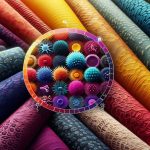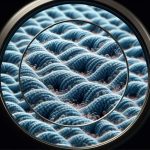You might not realize that naturally antimicrobial fabrics do much more than just combat odor. These materials can actually enhance skin health, reduce irritation, and even provide protection against harmful microbes. As you explore the benefits and applications of these fabrics, you’ll uncover how they can improve your well-being in various ways. What other advantages could these innovative textiles offer?
Table of Contents
Key Takeaways
- Naturally antimicrobial fabrics enhance skin health and prevent infections, offering benefits beyond just odor control.
- They reduce skin irritation and inflammation, making them ideal for sensitive skin.
- These fabrics create barriers against harmful bacteria and fungi, promoting overall health.
- Moisture-wicking properties keep users dry and comfortable, further enhancing their usability.
- Natural antimicrobial agents contribute to a healthier environment, making them sustainable alternatives to synthetic options.
Understanding Natural Antimicrobial Agents
When you think about antimicrobial agents, you might picture harsh chemicals, but many effective alternatives come from nature.
Natural antimicrobial agents, like silver, tea tree oil, and eucalyptus, have been used for centuries to combat bacteria and fungi. These substances work by disrupting microbial growth, offering a more eco-friendly option for fabric treatment.
You’ll find that these agents can be infused into textiles, providing lasting protection without the harsh side effects of synthetic chemicals. Fabrics treated with natural antimicrobials not only resist odors but also promote a healthier environment.
Benefits Beyond Odor Control
When you choose naturally antimicrobial fabrics, you’re not just tackling odors; you’re also promoting enhanced skin health and preventing infections.
These fabrics can offer sustainable options that benefit both you and the environment.
Let’s explore how these advantages go beyond mere freshness.
Enhanced Skin Health
While many people associate antimicrobial fabrics primarily with odor control, these innovative materials offer significant benefits for skin health as well.
By incorporating antimicrobial properties, these fabrics help reduce skin irritation and inflammation, making them ideal for sensitive skin. They create a barrier against harmful bacteria and fungi, promoting a healthier skin environment.
When you wear antimicrobial clothing, you might notice fewer breakouts and less discomfort during physical activities. This is especially beneficial for athletes or anyone who sweats frequently.
Plus, these fabrics often wick moisture away from your skin, keeping you dry and comfortable.
Ultimately, investing in antimicrobial fabrics not only keeps unpleasant odors at bay but also supports your skin’s overall health and well-being.
Infection Prevention Benefits
Antimicrobial fabrics do more than just enhance skin health; they play an essential role in preventing infections. When you wear these fabrics, you’re less likely to expose your skin to harmful bacteria and fungi.
This is especially important for active individuals or those in healthcare settings, where the risk of infection is higher. The inherent properties of these materials inhibit microbial growth, reducing the chances of skin irritations and infections caused by pathogens.
You’ll find that using antimicrobial textiles in clothing, bedding, or sports gear can provide an added layer of protection. By choosing these fabrics, you’re not only prioritizing comfort but also safeguarding your health and well-being from potential infections.
Sustainable Fabric Options
Choosing sustainable fabric options not only benefits the environment but also enhances your overall experience with clothing and textiles. By opting for materials like organic cotton, hemp, or Tencel, you’re supporting eco-friendly practices that reduce pollution and resource depletion.
These fabrics often possess natural antimicrobial properties, which help keep your garments fresher for longer. Sustainable options also tend to be more durable, meaning you’ll enjoy your clothes longer without frequently replacing them. This not only saves you money but also minimizes waste.
Plus, many sustainable fabrics are produced using less harmful chemicals, making them gentler on your skin. In choosing these alternatives, you’re investing in your well-being and contributing to a healthier planet.
Key Applications in Textiles
When you think about naturally antimicrobial fabrics, consider their essential roles in medical textiles and sustainable fashion.
These innovations not only enhance hygiene in healthcare settings but also promote eco-friendly practices in the fashion industry.
Let’s explore how these applications are shaping the future of textiles.
Medical Textile Innovations
As the healthcare industry evolves, innovations in medical textiles are transforming how we approach infection control and patient care.
You’ll find that advanced fabrics infused with antimicrobial properties are now commonplace in surgical gowns, drapes, and wound dressings. These textiles not only reduce the risk of hospital-acquired infections but also enhance patient comfort and recovery.
Features like moisture-wicking and breathability are designed to keep patients dry and comfortable during procedures. Additionally, smart textiles with embedded sensors can monitor essential signs and alert healthcare providers to potential issues in real-time.
Sustainable Fashion Solutions
While the fashion industry often faces criticism for its environmental impact, innovative sustainable fashion solutions are emerging to address these concerns. You can contribute to a greener future by choosing fabrics made from organic materials, recycled resources, or employing natural dyes. These solutions not only reduce waste but also promote healthier ecosystems.
Here’s a quick overview of key sustainable textile applications:
| Application | Description |
|---|---|
| Organic Cotton | Grown without harmful pesticides |
| Recycled Polyester | Made from plastic bottles |
| Natural Dyes | Plant-based, non-toxic coloring |
Comparison With Synthetic Antimicrobial Fabrics
Although both natural and synthetic antimicrobial fabrics serve the same purpose of inhibiting microbial growth, their properties and impacts differ markedly.
Natural fabrics, like hemp and wool, often come with inherent antimicrobial properties, making them biodegradable and eco-friendly. You can appreciate their breathability and comfort, which enhance wearability.
Natural fabrics, such as hemp and wool, offer built-in antimicrobial benefits while being biodegradable and comfortable for everyday wear.
On the other hand, synthetic fabrics, such as polyester treated with chemical agents, offer durability and consistent antimicrobial effectiveness. However, they may lack the same level of breathability and can contribute to environmental concerns at the end of their lifecycle.
When choosing between them, consider not only performance but also sustainability and your personal comfort preferences.
Ultimately, your choice will reflect your values and needs in antimicrobial textile solutions.
Challenges in Production and Stability
Producing naturally antimicrobial fabrics comes with several challenges that can impact their stability and overall effectiveness. You might encounter difficulties in sourcing raw materials that maintain their antimicrobial properties throughout the production process.
Inconsistent quality of natural fibers can lead to variability in performance. Furthermore, these fabrics often require specific conditions for processing, which can complicate manufacturing.
Another challenge is ensuring that the antimicrobial properties remain effective after multiple washes, as some natural agents may degrade over time. You also need to take into account consumer preferences for feel and durability, which can affect the adoption of these fabrics.
Balancing antimicrobial effectiveness with comfort and longevity is essential to creating a successful product in this competitive market.
Future Trends in Natural Antimicrobial Fabrics
As manufacturers navigate the challenges of producing naturally antimicrobial fabrics, they’re also looking ahead to innovative trends that could reshape the industry.
Here are three future trends you should keep an eye on:
- Smart Textiles: Integration of technology with natural fibers, enabling real-time monitoring of microbial activity and fabric performance.
- Sustainable Sourcing: A push for raw materials that not only provide antimicrobial properties but also align with sustainable practices, enhancing the fabric’s appeal.
- Biodegradable Treatments: Development of eco-friendly antimicrobial treatments that break down naturally, ensuring the fabrics are both effective and environmentally responsible.
These trends could greatly impact how you choose and use antimicrobial fabrics in the future, leading to healthier and more sustainable options.
Eco-Friendly Considerations in Manufacturing
While the demand for antimicrobial fabrics increases, manufacturers must prioritize eco-friendly practices to minimize environmental impact. You’ll want to look for companies that use sustainable materials, such as organic cotton or bamboo, which require fewer resources and chemicals.
Additionally, choose brands that implement environmentally friendly dyeing processes, reducing water pollution and waste. Transparency is key; opt for manufacturers that share their sustainability efforts and certifications.
By supporting these practices, you contribute to a healthier planet while enjoying the benefits of antimicrobial fabrics.
Finally, consider the lifecycle of the products: eco-conscious brands often focus on durability, ensuring that the fabrics last longer, thereby reducing the need for frequent replacements and further conserving resources.
Frequently Asked Questions
How Do Natural Antimicrobial Fabrics Affect Skin Health?
Natural antimicrobial fabrics can improve your skin health by reducing bacteria and irritation. They help prevent infections, promote healing, and maintain a balanced skin microbiome, keeping your skin feeling fresh and comfortable throughout the day.
Are There Any Allergies Associated With Natural Antimicrobial Agents?
Yes, some individuals can experience allergies to natural antimicrobial agents, like certain plant extracts or fibers. It’s essential to test fabrics before regular use, especially if you have a history of sensitivities or allergies.
Can Natural Antimicrobial Fabrics Be Reused or Washed Repeatedly?
Did you know that some natural antimicrobial fabrics can withstand up to 30 washes while retaining their properties? You can confidently reuse and wash these materials, ensuring hygiene without compromising their effectiveness over time.
What Is the Lifespan of Natural Antimicrobial Properties in Fabrics?
The lifespan of natural antimicrobial properties in fabrics varies, but you’ll typically find they last several washes. Over time, these properties can diminish, so regular care and maintenance are important to maximize their effectiveness.
How Are Natural Antimicrobial Fabrics Tested for Effectiveness?
Testing natural antimicrobial fabrics is like baking a cake; you mix ingredients and check results. Labs typically use methods like agar diffusion and bacterial counts to measure effectiveness, ensuring your fabric truly fights germs.
- How to Tie-Dye a Double Spiral Pattern - July 14, 2025
- The Box Folding Technique for Square and Diamond Patterns - July 14, 2025
- The RIT Dye vs. Fiber Reactive Dye Debate for Tie-Dye - July 14, 2025







